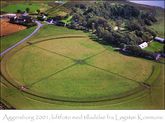Aggersborg and Lindholm Høje
Where the narrow eastern part of the Limfjord meets Løgstør Bredning, and the road from Viborg crosses over to the island that is North Jutland, in the latter part of the 10th century there lay the largest of Denmark's Viking Age ring forts, Aggersborg. Further West, North of Aalborg, lies a great burial ground. Today it is known as Lindholm Høje. It was in use from about AD until the end of the Viking Age, or perhaps a litlle later.
With its outer diameter of 288 metres, Aggersborg is the largest of the Viking Age geometric ring forts. They were all constructed according to a strict pattern, but whereas the other forts that have been investigated only contained four blocks, each with four houses, Aggersborg contained 12 blocks of four houses. The ring fort was built about AD 980 by Harald Bluetooth over the ruins of an earlier settlement and was functional for only a very short time; probably no more than 10-15 years. It was succeeded through the years by several royal residences.
Its location was strategically well chosen as the fort lies just at the point where the important road route between Viborg and Vendsyssel crosses the Limfjord.
There is much debate concerning the function of the ring forts. They were constructed at a time of great social, political, technological and cultural change in Denmark, during which the power of the king was also undergoing a transformation. They must have functioned as the king's military strongholds and demonstrations of power. With is special location, Aggersborg was probably to control the passage of vessels through the Limfjord, function as a gateway to Norway and a plcae for mobilazing the fleet for England.
Lindholm Høje
The site is famous for its many stone settings and there is a museum at the site today. The burial ground comprises almost 700 graves, but there would have been many more. Many of the stones have been removed through time. For example, in the 19th century large numbers of the stones were broken up and used for road-building material. The destruction was greatest in the area with Viking Age graves and almost none of these have survived. The great majority of the 700 graves that still exist are from the end of the Iron Age – i.e. just prior to Viking times. It is impossible to determine how many graves have been destroyed.
In the area around the burial ground, the remains have also been found of a couple of villages from the Viking Age. These sites have yielded both everyday items, such as whetstones, pots and ladles, and more luxurious wares such as drinking glass and semi-precious stones. Perhaps the richest people from the village travelled to Aalborg in order to buy wares such as these. Finds of Arabic silver coins demonstrate Lindholm Høje's international connections.
We don't know whether the inhabitants of Aalborg were buried at Lindholm Høje. But the Viking's burial grounds were often separated from their settlements by water – for example a watercourse. Perhaps Aalborg buried its citizens on the other side of the Limfjord – at Lindholm Høje.
Kristian Helmersen

